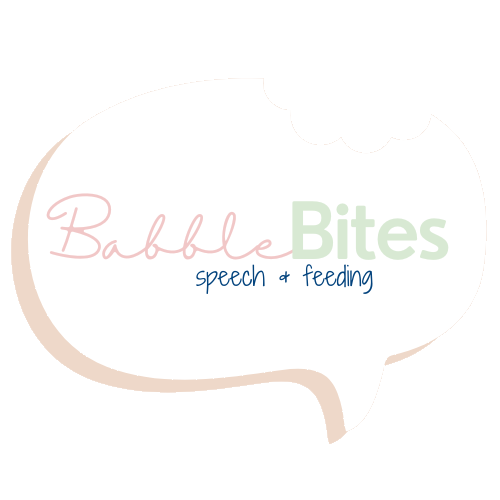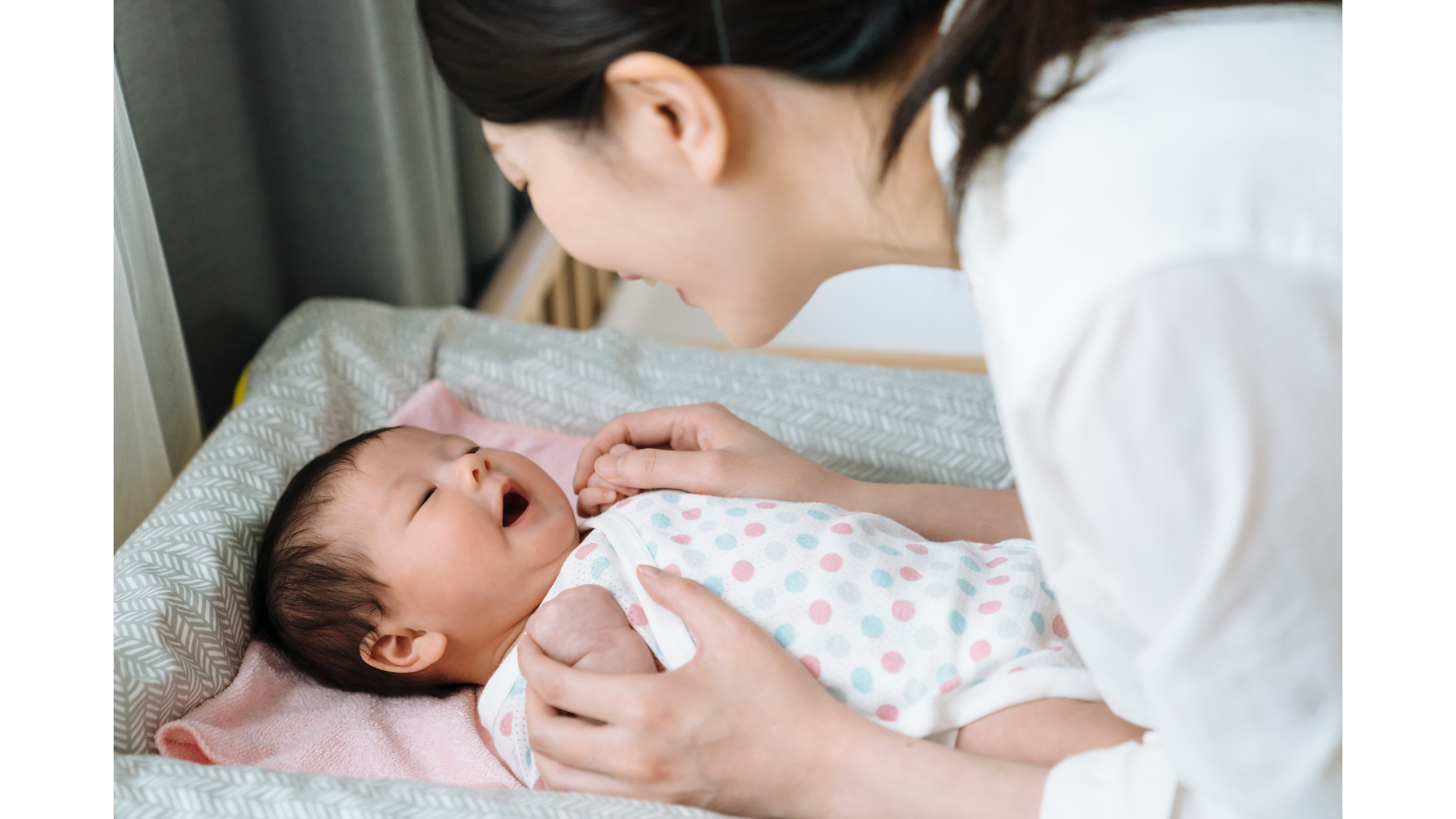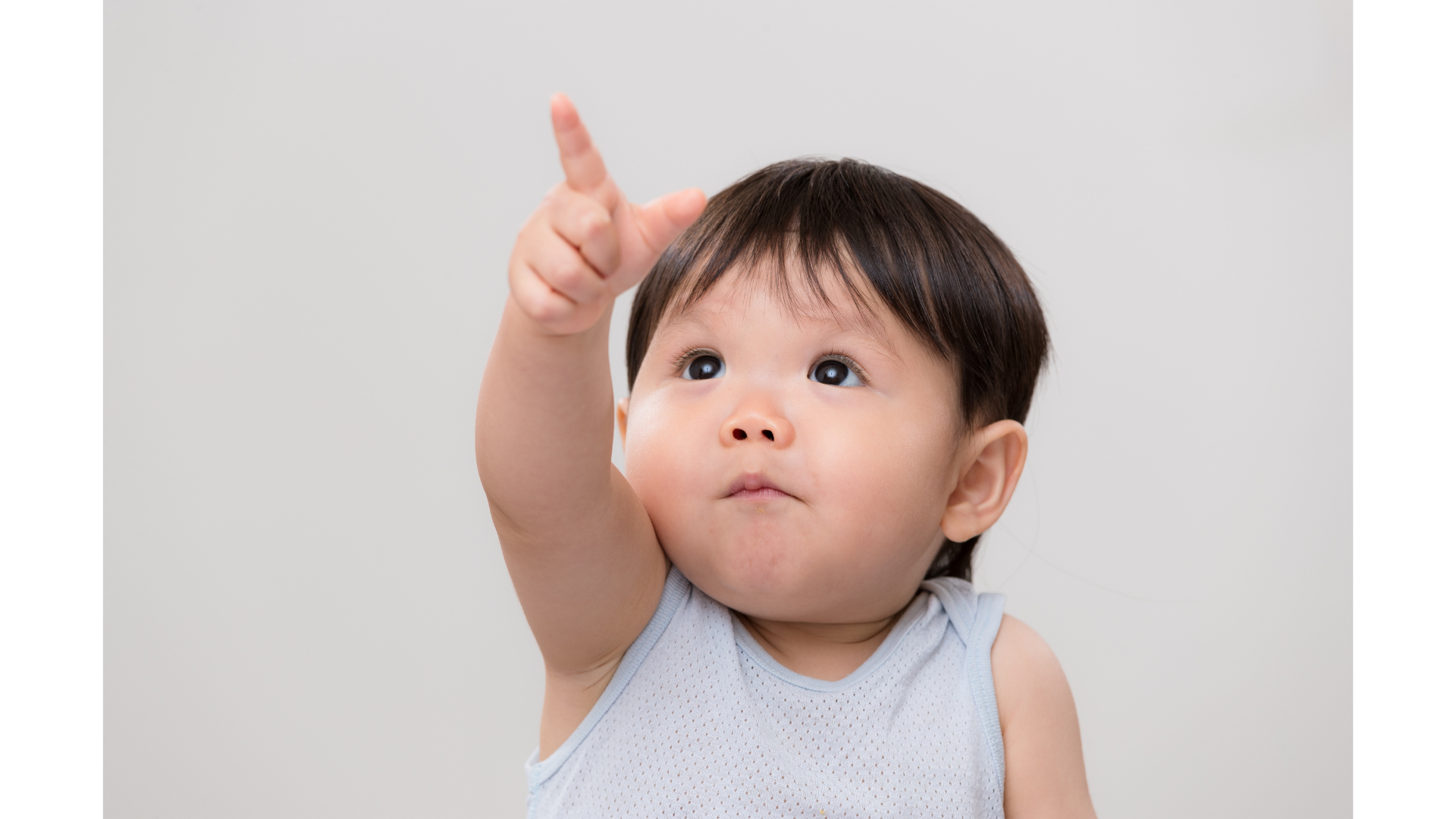What Comes Before First Words? The Importance of Pre-Linguistic Skills
Pre-linguistic, or pre-language, skills are non-verbal skills that babies learn, which are the building blocks for learning language. These skills help babies learn to interact with people in their environment, even though they’re not yet using words. Pre-linguistic skills are the foundation from which both learning and understanding language, as well as using words to communicate stems from.
Why are prelinguistic skills important?
When a child is not yet using words to communicate by the age we would expect them to, we (speech-language pathologists) will first look to see if they have developed pre-linguistic skills (or pre-language skills). Since pre-language skills are the foundation of language skills, it’s important to work on the development of these skills to support children learning to talk, and using words to communicate effectively. Language is symbolic, meaning gestures, facial expressions, tone of voice, and words all represent a specific meaning. Pre-linguistic skills are what help babies begin to understand these symbolic relationships.
Pre-linguistic skills and how to encourage their development:
Looking & Listening:
When baby is born, they are drawn to look at faces, particularly their caregivers’ faces. This early skill helps babies focus in on the face, use eye contact, and start to gain information about language from how the face and mouth moves. Listening to their caregivers’ voices also helps them learn to be able to filter out human voices from background noise, as well as to learn the voices of their caregivers. This eventually builds to them observing people around them, as well as attending to words spoken, which are necessary for learning to understand and use words.
Spending face to face time with your newborn will help encourage them to look at your face and listen to your voice.
How to encourage looking & listening:
Spend plenty of time face-to-face with your baby every day, including talking, playing, and showing objects such as toys and books. This face-to-face time is invaluable for them to learn to study your face and attend to what your saying and showing them.
Joint-attention:
This foundational language skill is when you and your baby are sharing an interest in something. This involves a three point shift in eye gaze, including shifting their eye gaze between the object of focus, to eye contact with their communication partner (e.g. mom or dad), and then back to the object, to indicate a shared attention to something. Joint attention involves both your child responding to your joint-attention, as well as initiating joint-attention. This skill is necessary in order for your child to share experiences with others which will build towards social, play, and conversational skills down the line.
How to encourage joint-attention:
You can encourage joint-attention by using anticipatory routines such as knocking a tower over, blowing bubbles, rolling a ball, a pop up toy, or pushing a car down a ramp. These activities involve both an interesting object, as well as the requirement of the adult to perform an action. By building the anticipation, such as with a verbal routine (e.g. “ready, set…” “go!”), once your child if familiar with this verbal routine, you can begin to pause after saying the first part (e.g. “ready, set…”) and look expectantly at your child (i.e. smile with your mouth slightly open, eyebrows raised). This will encourage your baby to shift their eye contact from the object to you, and then back to the object when you say the last part of the verbal routine (e.g. “go!”). You can also practice with favorite books while face-to-face with baby. Shift their attention by pointing to a picture in the book (even tap on the page to make a sound and further bring their attention to it), and then talking about the picture while pointing towards your face/mouth, then pointing back to the picture.
Smiling:
Around 6-8 weeks of age babies typically begin to make social smiles. Reflexive smiles can happen as soon as baby is born, and occur randomly such as while sleeping, or passing gas. Social smiles on the other hand, are in response to something external, such as hearing their parent’s voice or seeing their parent’s face.
Social smiles are in response to something in their environment, such as their mother smiling and talking with them.
How to encourage social smiling:
A great way to encourage social smiling is to spend lots of time face to face with your baby while talking, smiling, playing, and singing with them. When you see a social smile, reinforce it by smiling back and talking to your baby. Research has found using parentese (a sing-songy rhythm with higher-pitched tone of voice) can help bring your baby’s attention to your voice, which can in turn encourage more social smiling.
*Important note: A smile/laughter evoked from tickling is not a true smile/laugh, as it is reflexive. The reaction of laughing/smiling when tickled is misleading, as tickling can be a painful and/or unpleasant experience for many children. If children are pre-verbal, it may be even more difficult for children to express their discomfort. Watch for non-verbal signs such as facial grimacing, yelling, pushing away, and crying. When you do tickle, make sure it is playful, gentle, only a short duration at a time, and only continue if your child requests it (which may be a verbal or non-verbal request), as some children do enjoy it.
Imitation:
Another important foundational skill needed for language learning, imitation is when your baby copies you. This typically starts with simple motor movements (e.g. sticking out your tongue) and single vowel sounds (e.g. “ah,” “oh”) as early as 3 months of age, and advances to more complex imitation skills through their first year of life (e.g. clapping, blowing raspberries, facial expressions, early developing sounds /p, b, m, t, d, n, w/, syllables such as ma, ba), until eventually imitating their first words around 12 months!
How to encourage imitation:
Copy your baby! The best way to teach children to copy you, is to copy them. Not only do children enjoy when adults copy them, which helps strengthen social bonds, it will also teach them the concept of imitation and encourage them to imitate your gestures and sounds, and eventually words. While some researchers believe imitation skills are innate, more recent research has found that true imitation is a skill that needs to be taught and learned, therefore it’s critical to imitate your baby’s movements and sounds, to help them learn to imitate you. Imitate their coos, facial expressions, arm movements, and babbles. Babies often learn to imitate gross motor actions (e.g. big motions, like clapping) before fine motor actions (e.g. small muscle movements, like making sounds), so building imitation skills with big motions first is a great way to build skills needed for fine motor speech imitation.
Turn-taking:
Taking turns is a critical component of communication, and is how reciprocal interactions and conversations take shape later in development. The building blocks of turn-taking include your child exhibiting an action or sound and you responding, which then builds into a back-and-forth interaction. This can look like your child looking at something that you then gesture towards, your child making a sound and you speaking back to them, or your child pointing at something and you then commenting on it. This will develop into your child making sounds, you commenting back, then pausing and waiting for your child to respond (though it won’t be with words yet!) with either vocalizations or gestures, and then you responding, and so on and so forth. This helps children learn that communication requires back-and-forth exchanges between people.
How to encourage turn-taking:
When your baby looks towards something, makes a gesture, or produces a sound, respond to it, pause, and look expectantly at your baby (i.e. smile with your mouth slightly open, eyebrows raised). This will help them understand that it’s their turn in the conversation! When your baby is not saying words yet, it’s important to still respond to their vocalizations as if they are talking, so they can learn the foundations of conversational turn-taking. It’s also important to make sure you pause, so your baby has a chance to take their turn!
Anticipation:
This is when babies show their excitement in reaction to sounds and actions that are associated with and precede specific situations (e.g. “ready set…go!”, hearing food prepared, bath water running, approaching footsteps or voices). This anticipation reaction shows baby’s development of situational awareness, and the association between certain sounds, words, gestures, and facial expressions with specific routines and events. This can begin as early as 3 months of age, and their understanding of the meaning behind facial expressions, gestures, and words continues to develop as they grow older.
How to encourage anticipation:
Using verbal routines is a great way to build anticipation with your baby. This is when you say the same phrase or song every time you do a specific routine. This provides your baby with consistent expected language so they can more easily learn to associate the words with the upcoming routine. Click here for some verbal routines you can incorporate into your daily activities. You can also help build anticipation by pausing. For example, when using the “Ready, set, go” routine, try saying, “Ready, set….” and pause and look expectantly at your child (i.e. smile with your mouth slightly open, eyebrows raised). Providing a pause and an excited facial expression helps build anticipation before saying, “go!” and completing the action (e.g. blowing bubbles, rolling a ball, pushing a swing).
Blowing bubbles with baby can help work on anticipation skills by pausing before blowing the bubbles.
Expressions and Gestures:
Facial expressions and gestures will be some of the first ways your child learns to communicate specific wants and needs non-verbally. Babies will learn these skills first through imitation. Early gestures that start developing by 9-13 months of age include shaking head no, raising arms to request to be picked up, showing objects, waving hi/bye, pointing, clapping, and blowing kisses.
Babies learn to point to both request objects, and to bring others’ attention to objects, before developing use of words for these purposes.
How to encourage use of expressions and gestures:
Modeling different facial expressions and gestures are necessary for your child to learn to use them. You can also provide your child with hand-over-hand prompts to help them learn these gestures. Be consistent with modeling them, as well as pairing them with words (e.g. raising arms while saying “up,” pointing and saying, “look,” waving and saying, “hi” and “bye-bye”). When your child does use gestures, respond to them! If your child points, label the object they are pointing at, and get it for them (if this makes sense in the context, such as pointing at their water bottle). If your child waves, wave back and say, “Hi [baby’s name]!”
Vocalizations:
Babies start cooing as early as 6-8 weeks old, and are your baby’s first sounds besides crying. Cooing consists of vowel sounds (e.g. ahh, ooo), and gurgling-type sounds. Babbling can start as early as 4 months, and can be distinguished from cooing, as you will start to hear your baby making consonant sounds, first as single syllables (e.g. ba, da), followed by repetitions of the same syllable (e.g. mamama, bababa), and then variegated babbling and jargon, starting around 8-10 months, where they will mix different consonant and vowel sounds together (e.g. mabodu). Babies learn that when they make vocalizations, people respond to them, and that different vocalizations can serve different purposes. For example, they may learn that grunting can get their parents’ attention to look at or get them something, or that when they blow raspberries it makes mommy and daddy laugh. Eventually they will learn that certain sounds produced together have a specific meaning, like “mama” and “dada!”
How to encourage vocalizations:
Talking to your baby is an important part of speech and language development. Using parentese, a sing-songy and higher pitched tone of voice, can help your baby tune into the words and sounds you are saying, and has been proven to help advance early language development. Imitating your baby’s sounds can also encourage them to keep vocalizing, learn the concept of imitation (if you imitate them, they will learn to imitate you), and learn early “conversational” turn-taking (see how all of these pre-linguistic skills build on each other?!). If your child makes a sound that sounds like a word, respond to it as if they said that word! For example, if they babble, “mama,” respond back, “Yes I’m mama! Hi baby, what do you need?” If they say, “ba,” say, “Here’s the ball!” and give a ball to them if you’re in the room with one. This helps them connect that their vocalizations have specific meanings.
Understanding:
It is necessary for children to understand words before they use words functionally. If they do not yet understand what words mean, then they are not yet going to use words (at least not functionally to have their wants and needs met). Children first rely on visual cues, such as direction of eye gaze, pointing, gestures, and actions of others to understand. Over time, children will not need to rely as heavily on visual and gestural cues as they start to understand the words better.
How to encourage understanding:
Since children first rely on the use of visual cues to understand, it’s important to provide these to your children, such as when giving directions (e.g. point to the ball when you say, “Go get the ball”), or labeling objects (e.g. point to objects and label them). It is also helpful to simplify your full sentences into shorter single words and phrases. For example, “It’s time to go to the park, go get your shoes from your room,” can be broken down into, “Go get shoes.” This helps children pick out the key important words that otherwise may be missed in long sentences and the fast speech of adults.
What if I have concerns about my child’s language development and pre-linguistic skills?
If your child is reaching 12-18 months of age and is showing difficulty with some or all pre-linguistic skills such as not yet: making sustained eye contact, responding with a social smile, exhibiting vocal play and babbling, imitating and using facial expressions and gestures, showing things by pointing or eye gaze to bring your attention to it, exhibiting understanding of words, showing interest in what others say and show them, or responding to different tones of voice (e.g. happy, sad, angry), speak to your pediatrician about a referral to a speech-language pathologist for a speech-language evaluation. Difficulties with these underlying skills may develop into difficulties with receptive and expressive language (how children understand and use language), pragmatic/social language skills (difficulty interacting with others), play skills (difficulty imitating actions with toys and using toys to play), and behavior (when children do not understand or cannot communicate, they can easily become frustrated, as well as seem like they are not following directions). There are multiple factors involved in determining if a child requires speech-language therapy.
Early intervention has been proven to have better outcomes than the outdated “wait and see” approach, so speak to your pediatrician if you are concerned. Every state has a state-funded early intervention program, although these programs can be difficult to qualify for. If you are still concerned if your child doesn’t qualify (or if the waiting list is too long), you can reach out to a pediatric rehabilitation center or private practice in your area.
Follow us on Instagram for “bite-sized” information on language strategies:
This website and information on this blog post is provided for educational purposes only. It is not meant as medical advice, intended to replace a speech-language assessment, therapy from a speech-language pathologist, or serve as medical care for a child. It is recommended that you discuss any concerns or questions you might have with your speech-language pathologist, pediatrician, and medical team, and develop an individualized team plan specifically for your child.
Click below to pin this post to Pinterest to save for later and share!















